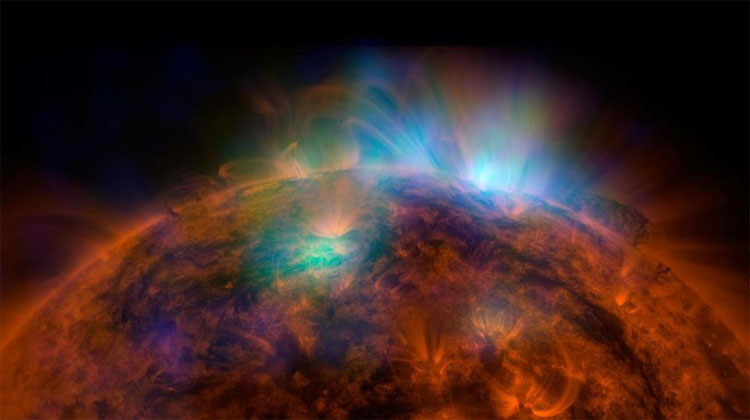One of the most surreal mysteries of the Sun has been decoded
The sun still hides many mysteries with people, but we are gradually deciphering it.
It takes 8 minutes for sunlight from the Sun to reach Earth, but scientists only need less time to solve this star's paradoxical paradox.
The sun is the solar system's host star, where our Earth is located, so it's obviously very hot. And with huge temperatures, approaching the surface of the Sun is definitely not possible. But there is a paradox: the Sun's surface temperature is not as hot as the atmosphere around it.

The surface temperature of the Sun is not as hot as the atmosphere around it.
The difference in temperature is not small either. Based on the spectral calculation, the surface temperature only falls to about 5,500 degrees Celsius, while the surrounding atmosphere - also called " corona " has a temperature of millions of degrees.
One of the most popular hypotheses ever originated in 1960. Scientists then agreed that the diurnal zone has a very dense burst of energy, releasing energy and plasma rays, causing The temperature of this area pushed up to a crazy level. However, this hypothesis faces many doubts, due to technological limitations that could not determine the viral explosions that occur every millisecond from the Sun.
And recently, thanks to the latest technology in research by Shinnosuke Ishikawa from the Japanese Space Exploration Agency, we finally got the real answer.

The sun emits radiation and the heat flow is very terrible.
It started with a sounding rocket - FOXSI-2 since 2014. The missile plays a role in determining the X-rays emitted from the Sun. It gives a short movie of just 7 minutes before falling to Earth, but that's more than enough for science to solve this question.
According to Ishikawa, the Sun emits radiation and the flow of heat is very terrible, so catching extremely small explosions (nanoflare) is extremely difficult."These explosions are millions of times smaller, even billions of times than normal explosions," he said. Meanwhile, the energy of each explosion can be equal to 10 billion tons of TNT.
By focusing on the result of FOXSI-2, Ishikawa identified the extremely large energetic X-rays emitted from the Sun, with temperatures up to millions of degrees C. This is because FOXSI-2 is 100 times more sensitive than the most advanced device people have ever owned.

Meteorological missiles are launched into space.
In the past, there was another hypothesis that explains the temperature of the Sun's solar region, which is because of the star's very strong magnetic field. But data from FOXSI-2 show that everything depends on nanoflare explosions only.
In the future, experts want to learn more about the specific nanoflare numbers that the Sun can emit every second, and determine the exact source of energy they bring. To do that, they will need FOXSI-3, even FOXSI-4.
The study was published in Nature Astronomy.
- Top 10 scientific mysteries
- Photos that capture the dream, push the imagination to the extreme
- Surreal photo: The world before I go to sleep
- Son Doong Cave has a surreal beauty scene on earth
- 7 historical mysteries seem to be impossible to solve forever, finally have the answer
- Collection of surreal 'surreal' landmarks that exist on Earth
- Admire the surreal scene in the world's largest tar lake
- 15 incredible fantasy images created from real photos
- Decoding the world's longest-lived human gene
- The ancient Aztec math system was decoded
- New way to decode ancient writing
- The mystery about 'Snowman' has been decoded?
 Van Allen's belt and evidence that the Apollo 11 mission to the Moon was myth
Van Allen's belt and evidence that the Apollo 11 mission to the Moon was myth The levels of civilization in the universe (Kardashev scale)
The levels of civilization in the universe (Kardashev scale) Today Mars, the sun and the Earth are aligned
Today Mars, the sun and the Earth are aligned The Amazon owner announced a secret plan to build a space base for thousands of people
The Amazon owner announced a secret plan to build a space base for thousands of people